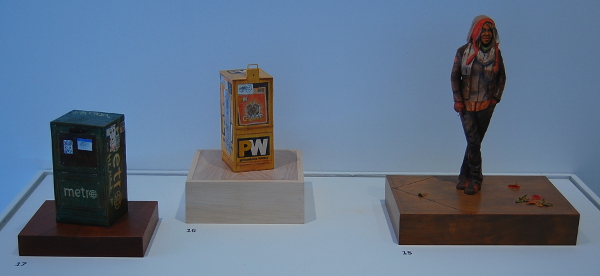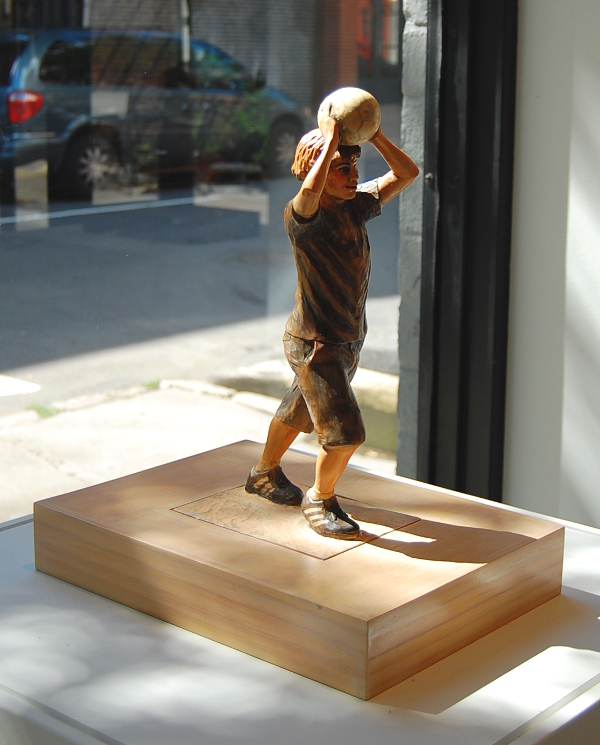
Susan Hagen examines all sorts in “Social Studies” at Center for Art in Wood
At the Center for Art in Wood, artist Susan Hagen captures the essence of what it means to be human in her solo show “Social Studies.” Here, Hagen painstakingly sculpts small (roughly a foot tall) figures out of wood and then burns, bleaches or paints their bodies into forms that come to life through their actions, settings and gazes.
One section of the exhibit finds completely white figurines in settings which most resemble a prison. Their monochromatic color scheme places an emphasis on the chisel marks in the wood that shapes their legs, torsos and various objects in their vicinity instead of their pigmentation. They seem ghostly in a way, offering a glimpse into another world which seems both distant and strangely tangible. In one scene, a band plays noiselessly with clarinet, trumpet, trombone and bass. Elsewhere two men tussle on the floor, toppled chairs and papers strewn about. For “Construction Workers,” two shirtless men stand aside a wheelbarrow full of rocks and gravel. One man digs his shovel into a ditch while his comrade looks on, appearing to pause and acknowledge the viewer.
Susan Hagen, “The Lost Army.”
Another series in which Hagen utilizes a single, solid color is “The Lost Army.” Her soldiers appear charred and battle-hardened, but stand loosely at attention in most cases, surely influenced by their rigorous training. Their remarkably similar appearance to one another lends itself to the concept of military uniforms and each of their titles is merely a number (Soldier #1, Soldier #2, etc.), hinting at the emphasis on the unit over self expression in a combat zone or barracks.
Susan Hagen (left to right), “Metro Newspaper Box,” “Philadelphia Weekly Newspaper Box,” and “September.”
Don’t be fooled by these two bodies of work, though. Hagen does embrace a bold and true-to-life paint selection in many of her other sculptures. For her “Citizens (People of Philly)” project, the artist turns to the characters in her daily life, many of whom may seem familiar to other denizens of Philadelphia. One man sits in a folding chair, one arm on a tabletop, the other resting on the brace around his knee. Physically this man, “Bruce,” seems powerful and bulky, but his knee brace tells a story of chronic pain and perhaps a rough, working-class life. In “September,” a woman stands relaxed in baggy autumn attire, a cigarette in one hand and leaves at her feet. Nearby, the commonplace sidewalk fixtures of Philadelphia Weekly and Metro newspaper boxes stand as a deviation from the heavily figurative show.
Susan Hagen, “Alejandro.”
Hagen also examines a cross-section of youth culture in her “Teenager Project.” The colors are perhaps the brightest here in the scarves and t-shirts that these figures don. Some of these faces are twisted into wry smirks, while others are deep in concentration, a soccer ball lifted above the head before a throw-in in one sculpture.
A view of some of Susan Hagen’s many Conté and ink drawings.
Throughout the show, Hagen provides drawings which serve as studies for these tiny individuals prior to her taking chisel to wood. Many of the three-dimensional people we see on the pedestals can also be found in the wall drawings which weave their way through the show.
Whether working in ink or hand-worked wooden forms, Susan Hagen places people first in an exhibit that opens a floodgate of the familiar and diverse. All manner of folks that comprise our friends, relatives, neighbors, and just about everyone else we know find their way into the show. “Social Studies” will be at the Center for Art in Wood through July 20.
The Center for Art in Wood is located at 141 North 3rd St., Philadelphia; 215-923-8000; centerforartinwood.org.
Recent Content
-
Artsarticle ·
-
Artsarticle ·
-
Artsarticle ·




